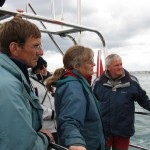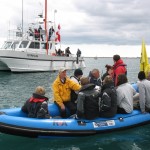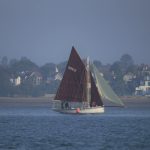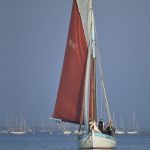Over the Bank Holiday weekend six TSC members (Andy Beharrell, George Rogers, Bob and Jilly Wilkinson and Roger and Sue Palmer) took part in the RYA Passage to Portland rally – one of many events the RYA is organising to mark the 2012 Olympics. Andy and George took Charmary to Portland to the Weymouth and Portland National Sailing Academy (WPNSA) – the Olympic and Paralympic sailing venue.
The rally was an eye opener, showing us the complexity of the exercise of organising an event like the Olympics. The rally was timed to coincide with the start of the Skandia Sail for Gold Regatta – a world series dinghy event being used by all the Olympic sailors as part of their preparation for the Olympics. The regatta has over 500 dinghies sailing with over 750 competitors at the WPNSA. The biggest surprise for us though was that this also meant that there were over 300 RIB’s! Each coach (and many of the sailors have personal coaches) has their own RIB, meaning that a whole marina was required just for the RIB’s. The RIB’s are all kitted out with weather stations so they can monitor the weather across the courses and coaches apparently carry tide sticks to measure the tide constantly. Chatting to one of the Principal Race Officers, he said that if he wants to know what the tide is doing at any time, he just asks one of the coaches!
The main activity for one of the days was to go out and watch the first day of sailing at the Sail for Gold Regatta. We started out by going out to the Nothe course. This is the course right under the Nothe that will be used for all the medal races during the games. The course was being used for the women’s match racing in the Elliot 6m. Initially we were trying to work out what was going on, but we had Sarah Ayton (double Olympic gold medallist in the Yngling) on board and she explained the process to us. Each team races each other twice in the initial round robin. They are allocated either the port or starboard end of the line for their first race and then in the second race, they switch ends. Yellow and blue flags on the leech indicate which boat is which. On the four minute they come in from their allocated end and come together usually coming head to wind in what is called the dial-up. They then each try to get on each other’s tail and force a penalty or force them to make an early or poor start. They are continuously followed by a jury boat each which will make an instant judgement in the event of an incident. They will either show a green and white flag which means they don’t believe there has been an infringement or they will show a yellow or blue flag meaning a penalty to that boat.
In the afternoon, we headed out to the 49er course. During a race postponement the PRO on this course, David Campbell-James, invited us on board the committee boat to have a look round. He gave us a fascinating insight into setting courses and managing a race course. A ‘reference point’ is set within the course area (which is a circle of around one and a half miles in diameter) and the line, the windward mark and the leeward gate are all set based around this point. What amazed us was the precision with which all this was done. He even had a table on board that gave him the distances required to change the line bias by as little as one degree! This committee boat was paid for by LOCOG and will be presented to the RYA after the games.
The wind then filled in and we got to watch a 49er race. The first start was abandoned with just over a minute to go as they gathered in a group at the pin end and the line was reset with the pin end dropped back a little. We saw the start and the first beat and run and then watched the second windward mark rounding as we headed in.
Watching Ben Ainslie pack up his Finn outside the tent as we had supper was a nice way to end the rally.
See the Passage to Portland picture gallery for further pictures.






